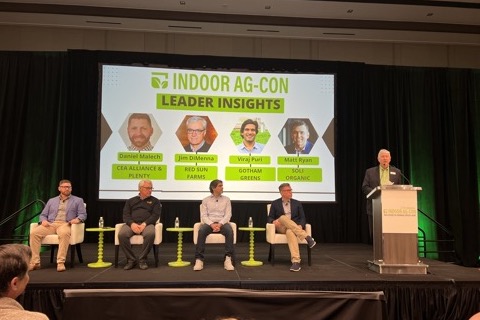3/22/2024
More Key Takeaways From Indoor Ag-Con
Jennifer Polanz
I was able to attend several panel discussions about a variety of topics, from balancing the environment to substrates and plant varieties, as well as a discussion from industry leaders. I’ve pulled out a few components from each.
On Environment (from Balancing For Success – Optimizing CO2, Light & Temperature):
- Panelist David Imberti from Percival Scientific noted to make sure sensors are properly calibrated to make sure there’s no heat load from lighting, or if there is to adjust for that. He also talked about air flow and the importance of temperature uniformity to avoid stressing the plants.
- Panelists were asked about AI learning and how that could impact growing. Rose Seguin, agronomist at Sollum Technologies said while autonomous systems can be integrated into a CEA operation, at the end of the day the data has to be correct and helpful to the grower. Using accurate data can help make a grower more efficient, but there will still be a human element.
- On the topic of efficacy, Karla Garcia, technical services at HortAmerica highlighted research on the ability to modify the light spectrum, like for example, adding far-red light during different times in production to enhance plant growth.
On Substrates (from Rooting Innovation: Cultivating Success with CEA Substrates):
The panelists talked about the importance of exploring different substrates and formulations in addition to existing products made with peat and wood to meet increasing demand for soilless growing media. Examples include a charged carbon-based product that can stand alone, as well as biochar and coco coir that can be added to existing substrates.
In North America there’s no regulatory pressure against peat (like there is in Europe), but the increased demand, along with a couple of rainy seasons during peat harvesting, has prompted companies to look for new formulations. That makes R&D and grower trials more important to determine how certain crops and growing systems react with the substrates. To that end the panelists talked about having a dedicated person on staff to set up trials, and the importance of someone from the substrate company providing on-site support. It’s important to note, too, that different substrate formulations may impact irrigation, lighting and other environmental considerations.
On Varieties (from Seeds of Success: Navigating Variety Selection for Thriving Indoor Crops):
A couple of interesting items came out of this session on sourcing seeds and production practices. One of them came when an attendee asked if they could receive growing best practices from the breeding companies. The companies often can’t help because of the proprietary nature of many indoor growing systems, both in terms of secrecy and the uniqueness of each growing operation. Until our industry has more standardized growing practices, each grower may have to find their own way, is the message I took away from this session.
Another interesting item was about growing a variety of crops, and how production facilities need to be set up to separate some crops to accommodate specific growing conditions. For example, a lettuce operation may have difficulty growing spinach unless that environment is separated out and set up differently. That can take money, time and resources.
 Pictured: Leader Insights Panelists (from left to right): Dan Malech, Plenty; Jim DiMenna, Red Sun Farms; Viraj Puri, Gotham Greens and Matt Ryan, Soli Organic.
Pictured: Leader Insights Panelists (from left to right): Dan Malech, Plenty; Jim DiMenna, Red Sun Farms; Viraj Puri, Gotham Greens and Matt Ryan, Soli Organic.
On CEA (from Leader Insights: Charting the Future Landscape of Controlled Environment Agriculture):
Based on retailer data and market penetration, leafy greens saw growth in 2023 over 2022 numbers, according to Viraj Puri, co-founder and CEO of Gotham Greens. He noted, too, that not all indoor production is the same, and often it comes down to the fact that you have be a good grower to succeed. Later in the session, he noted locally grown continues to be a powerful message for CEA growers.
Matt Ryan, CEO of Soli Organic, in response to a question about sustainability, said their organics messaging remains valuable to the consumer to distinguish their product and command a premium price. Right now, though, he added, the sustainability message overall means more to growers and retailers than it does to the end consumer.
It’s not moving the needle yet, but “that is going to continue to evolve, and we have to lean into it because ultimately that is going to be how we’re going to create real value, especially with domestic suppliers versus international, and we need to get to the point where people start to understand that. It’s just going to take some time.”
When asked about food safety, Jim DiMenna, President of Red Sun Farms, said it’s top of mind for them every day. “We have people designated to monitoring and manage that every day,” he said. “We test, we want to make sure our teams are really engaged in food safety all the way through as much as we can manage.” Viraj agreed, saying it’s important as an industry we don’t tout that CEA growers are immune to food safety issues, because recalls can happen, and it’s an area they focus on heavily with a team dedicated to it. To that point, Matt noted one incident can taint the whole indoor industry. “It’s table stakes, he added. “It’s incredibly important for us, and it needs to be for everybody who does anything in this industry because one incident taints all of us.”